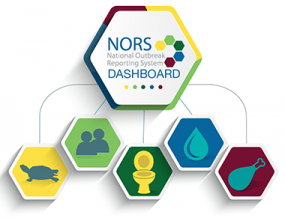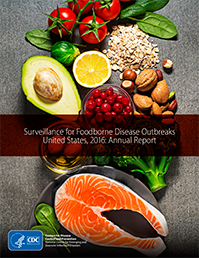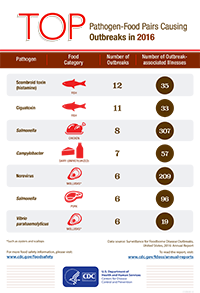Highlights from the 2016 Surveillance Report
When two or more people become ill from consuming the same contaminated food or drink, the event is called a foodborne disease outbreak. Outbreaks provide important insights into how pathogens (germs, chemicals, or toxins) are spread, which food and pathogen combinations make people sick, and how to prevent food poisoning. Each year, CDC summarizes foodborne disease outbreak data in an annual surveillance report and makes it available to the public through the NORS Dashboard.
Main Findings
In 2016, 839 foodborne disease outbreaks were reported, resulting in 14,259 illnesses, 875 hospitalizations, 17 deaths, and 18 food recalls.
- Single food categories associated with the most outbreak illnesses:
- Mollusks, such as oysters and scallops (529 illnesses)
- Pork (438 illnesses)
- Grains and beans (383 illnesses)
- Single food categories associated with the most outbreaks:
- Fish (26 outbreaks)
- Mollusks (21 outbreaks)
- Dairy (19 outbreaks)
- Restaurants were the most commonly reported location where food was prepared (459 outbreaks, 61% of outbreaks reporting a single location of preparation), specifically restaurants with sit-down dining (363, 48% of outbreaks).
- There were 39 multistate outbreaks, including the following types of foods linked to them:
- Sprouts (4 outbreaks)
- Beef (3 outbreaks)
- Seeded vegetables, such as cucumbers (3 outbreaks)
- Fruit (3 outbreaks)
- Nuts and seeds (3 outbreaks)
- Chicken (2 outbreaks)
- Vegetable row crops, such as leafy greens (2 outbreaks)
Other Highlights
A single, confirmed pathogen caused 399 outbreaks. The most commonly reported were:
- Norovirus (145 outbreaks, 36% of the outbreaks)
- Salmonella (132 outbreaks, 33% of the outbreaks)
A single, confirmed pathogen caused 9,123 outbreak-related illnesses, 812 hospitalizations, and 15 deaths. The most common causes of outbreak-related illnesses were:
- Norovirus (3,794 illnesses, 42% of the illnesses)
- Salmonella (3,047 illnesses, 33% of the illnesses)
- Clostridium perfringens (512 illnesses, 6% of the illnesses)
The pathogens that caused the most outbreak-related hospitalizations were:
- Salmonella (456 hospitalizations, 56% of outbreak-related hospitalizations)
- Hepatitis A virus (141 hospitalizations, 17% of outbreak-related hospitalizations)
- Shiga toxin-producing Escherichia coli (98 hospitalizations, 12% of outbreak-related hospitalizations)
The pathogens that caused outbreak-related deaths were:
- Listeria monocytogenes (3 deaths)
- Salmonella (3 deaths)
- Shiga toxin-producing Escherichia coli (3 deaths)
- Clostridium botulinum (2 deaths)
- Hepatitis A virus (2 deaths)
- Clostridium perfringens (1 death)
- Staphylococcus aureus (1 death)
- Vibrio cholera (1 death)
Investigators were able to identify the food that made people ill in 38% of the outbreaks (323 outbreaks). The food could be placed into a single category, out of 24 possible categories, in slightly more than half of those outbreaks (180). The most commonly implicated food categories were:
- Fish (26 outbreaks, 14% of the outbreaks)
- Mollusks (21 outbreaks, 12% of the outbreaks)
- Dairy (19 outbreaks, 11% of the outbreaks): all involved raw (unpasteurized) products
- Pork (18 outbreaks, 10% of the outbreaks)
Outbreaks in which the food could be classified into a category resulted in 3,776 illnesses. Outbreak-associated illnesses were most commonly from:
- Mollusks (529 illnesses, 14% of the illnesses)
- Pork (438 illnesses, 12% of the illnesses)
- Grains and beans (383 illnesses, 10% of the illnesses)
- Chicken (356 illnesses, 9% of the illnesses)
Knowing which pathogen and food combinations make people sick is important for preventing outbreaks. The confirmed pathogen-food pairs responsible for the most outbreaks were:
- Scombroid toxin (histamine poisoning) in fish (12 outbreaks)
- Ciguatoxin in fish (11 outbreaks)
- Salmonella in chicken (8 outbreaks)
The confirmed pathogen-food pairs responsible for the most illnesses, hospitalizations, and deaths were:
- Illnesses
- Bacillus cereus in grains and beans (348 illnesses)
- Salmonella in chicken (307 illnesses)
- Hepatitis A virus in mollusks (281 illnesses)
- Hospitalizations
- Hepatitis A virus in mollusks (71 hospitalizations)
- Hepatitis A virus in fruits (57 hospitalizations)
- Salmonella in beef (44 hospitalizations)
- Deaths
- Hepatitis A virus in mollusks (2 deaths)
- Listeria monocytogenes in dairy (2 deaths): all involved raw (unpasteurized) products
*The term “pathogens” as used here includes other agents, such as toxins.
Among the 751 outbreaks and 12,622 illnesses with a reported single location where food was prepared, 459 outbreaks (61%) and 5,353 associated illnesses (42%) were attributed to foods prepared in a restaurant.
Among these outbreaks, sit-down dining restaurants were most commonly reported as the location where food was prepared (363 outbreaks, 48% of the outbreaks).
Product recalls occurred in 18 outbreaks:
- Oysters (3 outbreaks)
- Beef (2 outbreaks)
- Raw milk (2 outbreaks)
- Alfalfa sprouts (1 outbreak)
- Cheese (1 outbreak)
- Cilantro (1 outbreak)
- Cucumbers (1 outbreak)
- Frozen scallops (1 outbreak)
- Frozen strawberries (1 outbreak)
- Hazelnuts (1 outbreak)
- Masa dough (1 outbreak)
- Pistachios (1 outbreak)
- Seaweed and sea asparagus (1 outbreak)
- Shell eggs (1 outbreak)
In 2016, there were 39 multistate outbreaks (5% of all reported outbreaks), resulting in 1,055 illnesses (7% of illnesses), 283 hospitalizations (32% of hospitalizations), and 8 deaths (47% of deaths).
Pathogens responsible for multistate outbreaks:
- Salmonella (28 outbreaks)
- Shiga toxin-producing Escherichia coli (7 outbreaks)
- Listeria (2 outbreaks)
- Hepatitis A virus (1 outbreak)
- Norovirus (1 outbreak)
Foods implicated or suspected in multistate outbreaks of Salmonella:
- Chicken (1 confirmed, 1 suspected; 2 outbreaks total)
- Cucumber (2 outbreaks)
- Alfalfa sprouts (suspected; 1 outbreak)
- Avocado (suspected; 1 outbreak)
- Bean sprouts (suspected; 1 outbreak)
- Cantaloupe (1 outbreak)
- Eggs (1 outbreak)
- Ground beef (1 outbreak)
- Hazelnuts (1 outbreak)
- Mung bean sprouts (suspected; 1 outbreak)
- Nuts (1 outbreak)
- Onion (suspected; 1 outbreak)
- Peppers (1 outbreak)
- Pistachios (1 outbreak)
- Pork (suspected; 1 outbreak)
- Prepackaged leafy greens (1 outbreak)
- Salad mix (1 outbreak)
A food was not identified for nine multistate outbreaks caused by Salmonella.
Foods implicated or suspected in multistate outbreaks of Shiga toxin-producing Escherichia coli:
- Beef (2 outbreaks) (serogroup O157)
- Alfalfa sprouts (1 outbreak) (serogroup O157)
- Iceberg lettuce (suspected; 1 outbreak) (serogroup O157)
A food was not identified for three multistate outbreaks caused by Shiga toxin-producing Escherichia coli.
Food implicated in a multistate outbreak of Listeria:
- Raw (unpasteurized) soft cheese (1 outbreak)
A food was not identified for one multistate outbreak caused by Listeria.
Food implicated in a multistate outbreak of hepatitis A virus:
- Strawberries (1 outbreak)
A food was not identified for one multistate outbreak caused by norovirus.
Nine multistate outbreaks investigated in 2016 are not included in the 2016 tally because the first outbreak-associated illness occurred before 2016. Four were caused by Salmonella; the implicated foods were chia seed powder (first illness in 2014), alfalfa seeds and sprouts (first illness in 2015), cucumber (first illness in 2015), and moringa leaf powder (first illness in 2015). Three outbreaks were caused by Listeria. The implicated food in one Listeria outbreak was prepackaged lettuce (first illness in 2015). Hummus (first illness is 2013) and smoked fish (first illness in 2014) were suspected sources in two Listeria outbreaks. Lastly, two outbreaks were caused by Shiga toxin-producing Escherichia coli. Flour was the confirmed food implicated in one outbreak (first illness in 2015) and pizza dough mix was the suspected food implicated in the other (first illness in 2015).
More Information
Foodborne diseases due to known pathogens are estimated to cause about 9.4 million illnesses each year in the United States. Even though only a small proportion of these illnesses occur as part of a recognized outbreak, the data collected during outbreak investigations provide insights into the pathogens and foods that cause illness. Public health officials, regulatory agencies, and the food industry can use these data to help make food safer from farm to table.
The data from this report come from CDC’s Foodborne Disease Outbreak Surveillance System (FDOSS). State, local, and territorial health departments report the results of foodborne disease outbreak investigations to this system, and CDC provides an annual summary of outbreak investigations.
When comparing data between years, it is important to note that changes were made to this surveillance system in 2009, and a new food categorization scheme was implemented in 2011.
The findings in this report have at least three limitations. First, only a small proportion of foodborne illnesses that occur each year are identified as being associated with outbreaks. The extent to which the distribution of food vehicles and locations of preparation implicated in outbreaks reflect the same vehicles and locations as foodborne illnesses not associated with outbreaks is unknown. Similarly, not all outbreaks are identified, investigated, or reported. Second, many outbreaks had an unknown etiology (cause), an unknown food vehicle, or both, and may not be well represented by those outbreaks in which a food vehicle or etiology could be identified. Finally, CDC’s outbreak surveillance system is dynamic. Agencies can submit new reports and change or delete reports as information becomes available. Therefore, the results of this analysis might differ from those in other reports.

NORS Dashboard is CDC’s interactive online program for searching and accessing data from the National Outbreak Reporting System (NORS), which includes the Foodborne Disease Outbreak Surveillance System. NORS Dashboard lets search foodborne disease data by year, state, food and ingredient, location where food was prepared, and cause. It provides information on numbers of illnesses, hospitalizations, deaths, the germ, and the confirmed or suspected cause.
For guidance on using the data and limitations to keep in mind when searching by food or ingredient, take a look at frequently asked questions about NORS Dashboard.
Surveillance for Foodborne Disease Outbreaks — United States, 2009–2015 describes 7 years of data about the causes of outbreaks, where they occur, and the foods responsible for the most outbreaks, illnesses, hospitalizations, and deaths.
Although foodborne disease outbreaks are a nationally notifiable condition, many factors can influence outbreak investigation and reporting, including available resources (such as time, staff, and laboratory capacity), health department priorities, and the characteristics of an outbreak (such as its size and severity).
Even the most thorough investigations can fail to identify the contaminated food under certain circumstances, such as when most of the people who became sick ate many of the same foods (making it hard to identify the one that caused them to become ill), the number of people ill is very small, or the outbreak is identified after people’s memories of what they ate before getting sick have faded. CDC encourages health departments to report all foodborne outbreak investigations. Even if the contaminated food is not determined, we can learn useful information that can help shape prevention efforts.
Even well-conducted investigations may not be able to identify the causal agent of an outbreak. Several factors influence whether investigators can identify the causal agent, including the timing of when a specimen is obtained.
- Infections are often diagnosed using specific laboratory tests that can identify bacteria, chemical agents and toxins, parasites, and viruses. When an outbreak is not identified until after the optimal time to obtain specimens from ill people, it may not be possible to obtain specimens for laboratory analysis or the laboratory tests may be negative.
- When timely specimens are obtained, other factors can lead to the causal agent not being detected. For example, clinical laboratories may not have the resources needed to identify some germs. In these outbreaks, the state public health laboratory or CDC may perform additional tests to try to identify the germ.
Even if the causal agent is not identified, CDC encourages states to report all foodborne disease outbreak investigations because much can be learned about the settings of outbreaks, populations affected, and factors leading to food contamination.


